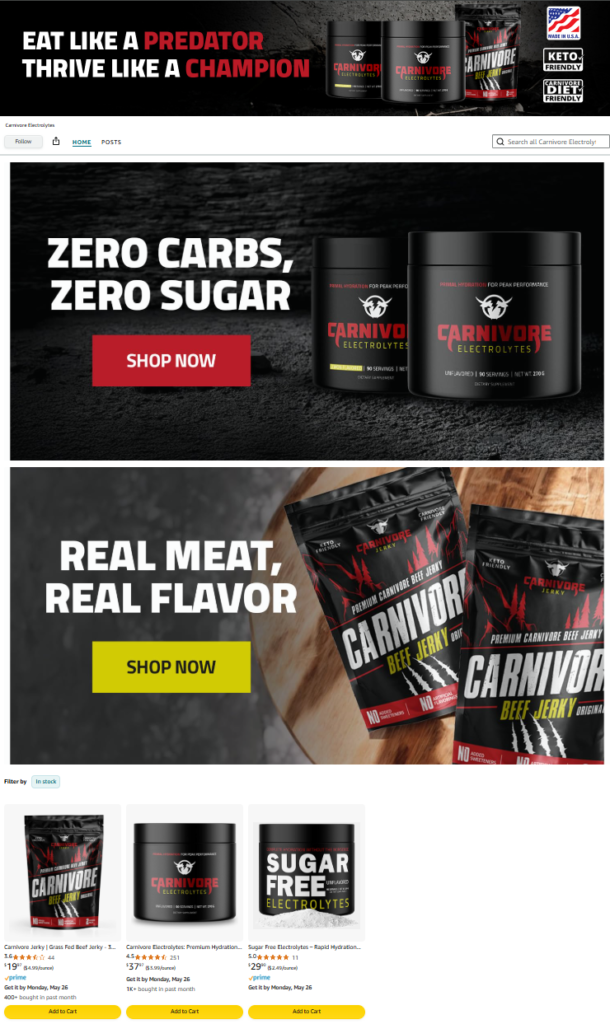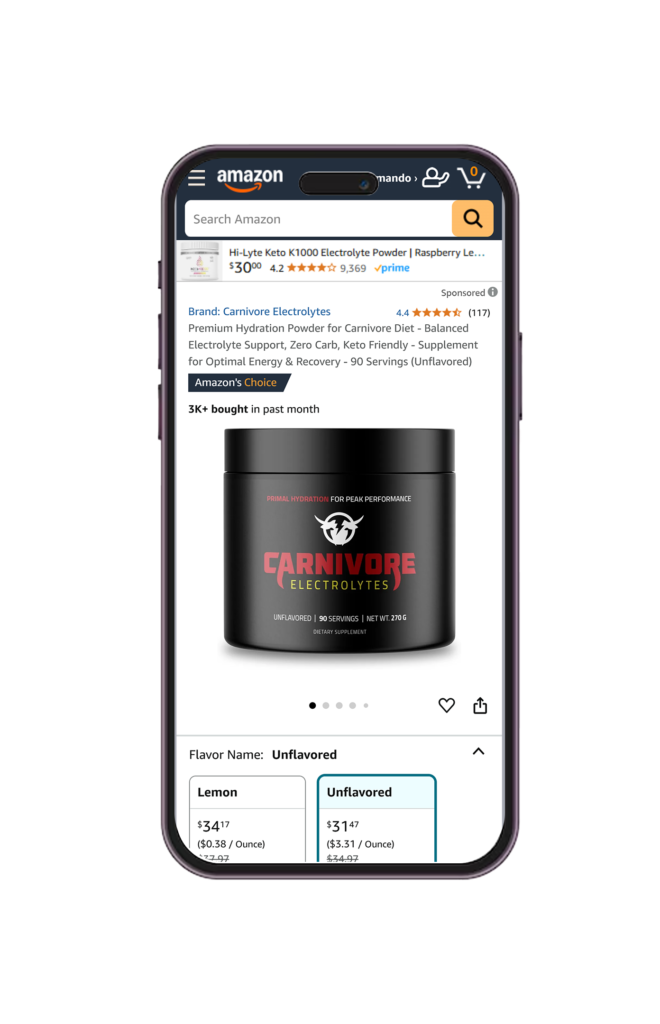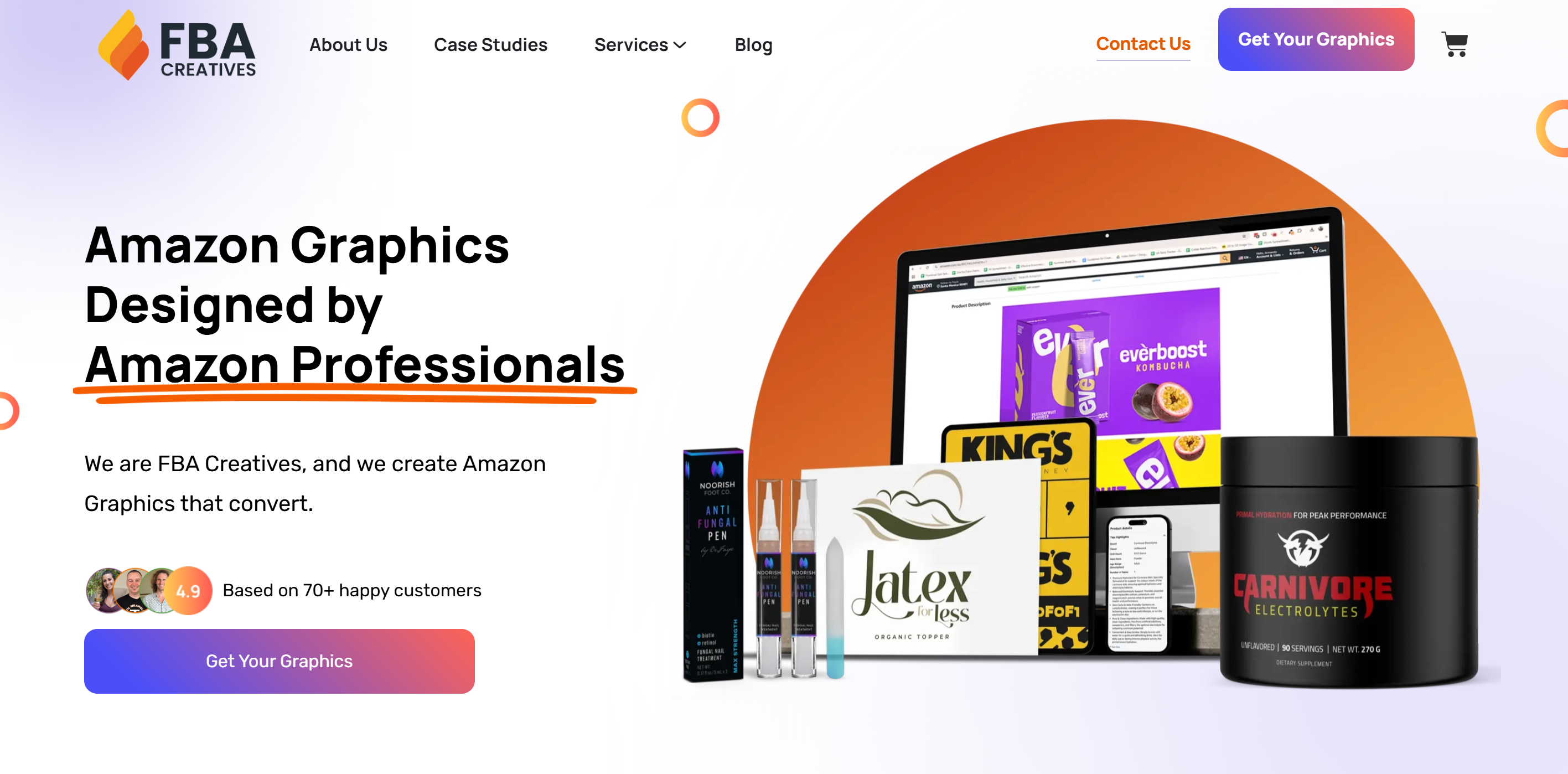
This Is Everything Your Amazon Brand Storefront MUST Include
Tips That Actually WorK
In today’s rapidly evolving e-commerce world, standing out on Amazon is no longer optional; it’s essential. Your Amazon Brand Storefront acts as a digital showcase, giving your brand a unique identity within the Amazon ecosystem. When done right, it becomes a powerful sales machine that not only attracts potential customers but also converts casual browsers into loyal buyers.
One of the most crucial elements that can dramatically impact the success of your storefront is your Amazon Listing Images. These images serve as your silent salespeople, working around the clock to entice shoppers, demonstrate product value, and build trust.
In this guide, we’ll explore everything your Amazon Brand Storefront should include, providing actionable insights and highlighting why hiring experts might just be your smartest investment.
- Why a Well-Designed Amazon Brand Storefront Matters
- Establishing Your Brand Identity
- High-Quality Amazon Listing Images: The Cornerstone of Success
- Types of Amazon Listing Images You Must Include
- Creating Eye-Catching Product Videos
- Optimizing Product Titles and Descriptions
- Leveraging A+ Content (Enhanced Brand Content)
- Cross-Selling and Upselling Strategies
- Utilizing Customer Reviews and Testimonials
- Mobile Optimization: Reaching Shoppers on the Go
- SEO Strategies for Amazon Storefronts
- Regularly Updating and Testing Your Storefront
- The Benefits of Hiring Amazon Storefront Experts
- Common Mistakes to Avoid
- Future Trends in Amazon Brand Storefronts
- Your Roadmap to Amazon Storefront Success
- Frequently Asked Questions (FAQs)
Why a Well-Designed Amazon Brand Storefront Matters

First and foremost, a well-designed Amazon Brand Storefront significantly enhances your brand’s credibility. When customers land on your page, they immediately form an impression based on its appearance and organization. A polished and professional storefront signals that your brand takes quality seriously, which helps to instill confidence in potential buyers.
Moreover, a thoughtfully curated storefront builds trust. Shoppers are far more likely to purchase from brands that present clear, consistent, and high-quality information. This trust translates directly into higher conversion rates. In fact, numerous studies have shown that consumers are more willing to buy from brands that provide a seamless and visually appealing shopping experience.
Ultimately, your storefront isn’t just a static page—it’s a dynamic marketing tool. When optimized effectively, it can serve as the cornerstone of your Amazon sales strategy, driving both immediate purchases and long-term brand loyalty.
Establishing Your Brand Identity

To truly captivate your audience, your Amazon Brand Storefront must clearly convey your brand identity. This goes far beyond simply uploading a logo; it involves creating a cohesive and memorable experience that resonates with your target market.
Start by prominently featuring your logo and using a consistent color scheme that reflects your brand’s personality. These visual elements create a sense of familiarity, making your storefront easily recognizable and professionally cohesive.
Additionally, your brand story plays a crucial role in setting you apart from competitors. By sharing your mission, values, and the inspiration behind your products, you create an emotional connection with your audience. Customers are more likely to support brands they feel personally connected to, which can result in increased loyalty and advocacy.
As you establish your brand identity, every element of your storefront—from banners to product descriptions—should work together harmoniously to reinforce who you are and why customers should choose you.
High-Quality Amazon Listing Images: The Cornerstone of Success
Without a doubt, Amazon Listing Images are one of the most influential elements in driving conversions on your storefront. Since customers cannot physically touch or test your products, your images must serve as the bridge between curiosity and confidence. High-quality images provide the visual assurance shoppers need to feel secure in their purchasing decisions.
Professional imagery not only showcases your product’s features but also conveys a sense of reliability and quality. The psychological impact of sharp, clear, and informative images cannot be overstated. Shoppers are naturally drawn to products that appear well-presented, believing that the attention to visual detail reflects the care put into the product itself.
Moreover, Amazon has specific guidelines for listing images that every seller must follow. These guidelines cover aspects such as image size, resolution, background color, and acceptable content. Adhering to these standards not only ensures compliance but also maximizes the visibility and appeal of your products.
By prioritizing high-quality Amazon Listing Images, you lay a solid foundation for your storefront’s success. They captivate attention, communicate value, and ultimately persuade customers to click “Add to Cart.”
Types of Amazon Listing Images You Must Include

To fully leverage the power of Amazon Listing Images, it’s important to include a variety of image types that address different aspects of the customer’s decision-making process. Let’s explore the essential categories:
Main Product Image:
This is your primary image and the first thing potential customers will see. It should feature a clear, high-resolution shot of your product on a pure white background, as per Amazon’s guidelines. This image must be crisp and detailed to immediately capture attention.
Infographics Highlighting Features:
Infographics combine text and visuals to quickly communicate key product benefits, features, and specifications. They help shoppers understand what sets your product apart, often reducing the need to read lengthy descriptions.
Lifestyle Images Showcasing Usage:
These images depict your product being used in real-life scenarios. They allow customers to visualize how the product fits into their own lives, making the purchase feel more personal and relevant.
Comparison Charts:
When applicable, comparison charts can highlight the advantages of your product over competitors or other models you offer. This transparent approach empowers customers to make informed decisions.
User-Generated Content and Customer Photos:
Incorporating authentic photos from actual customers can significantly boost trust and credibility. Potential buyers appreciate seeing how others are enjoying your product, which often serves as a compelling form of social proof.
By including a diverse range of Amazon Listing Images, you provide a comprehensive visual narrative that addresses various customer concerns and enhances their confidence in your product.
Creating Eye-Catching Product Videos
In addition to still images, product videos offer another dynamic way to engage potential buyers. Videos allow you to demonstrate your product’s features, highlight its benefits in action, and provide a more immersive shopping experience.
The power of video marketing lies in its ability to convey information quickly and memorably. Demonstration videos, for example, show your product being used effectively, eliminating doubts about functionality. Customer testimonial videos can also add a layer of authenticity, as real users share their positive experiences.
Furthermore, unboxing videos offer a unique opportunity to build excitement and anticipation, while simultaneously showcasing your product’s packaging and presentation. These videos complement your Amazon Listing Images by filling in the experiential gaps that photos alone cannot cover.
When used strategically, product videos can greatly enhance the persuasive power of your Amazon Brand Storefront, leading to higher engagement, better conversion rates, and increased customer satisfaction.
Optimizing Product Titles and Descriptions
Once you’ve captured attention with stellar Amazon Listing Images and videos, your product titles and descriptions step in to seal the deal. These written elements must be clear, engaging, and optimized to ensure that your listings are easily discoverable through Amazon’s search algorithms.
Start with your product titles. They should include your most relevant keywords while remaining concise and readable. Instead of keyword stuffing, aim for a natural flow that informs customers while boosting your SEO rankings. For example, include essential details such as brand name, product type, key features, and size or quantity.
Moving on to product descriptions, focus on the benefits rather than just the features. Help customers envision how your product will solve a problem or enhance their lives. Use bullet points to break down key features into digestible chunks, making it easier for shoppers to scan and absorb the information quickly.
When your titles and descriptions work hand-in-hand with your Amazon Listing Images, you create a compelling, informative listing that answers questions before they arise and guides shoppers toward a confident purchase.
Leveraging A+ Content (Enhanced Brand Content)

To take your Amazon Brand Storefront to the next level, leveraging A+ Content (formerly Enhanced Brand Content) is essential. This feature allows brand-registered sellers to create rich, visually appealing product pages that combine high-quality images, comparison charts, and detailed narratives.
A+ Content offers multiple modules you can use to highlight various aspects of your product. For instance, you can include detailed product specifications, storytelling modules that dive deeper into your brand’s mission, and high-resolution images that emphasize unique features.
One of the standout benefits of A+ Content is how it synergizes with your Amazon Listing Images. By presenting additional visuals and information, you can overcome any remaining objections a customer might have. Moreover, studies have shown that A+ Content can significantly boost conversion rates, making it a highly effective tool in your Amazon strategy.
By investing in A+ Content, you not only enhance the shopping experience but also establish your brand as professional and trustworthy—key factors that lead to increased sales and customer loyalty.
Cross-Selling and Upselling Strategies
Another highly effective way to maximize your Amazon Brand Storefront’s revenue potential is through cross-selling and upselling. When executed correctly, these strategies encourage customers to explore more of your product offerings and increase their average order value.
Begin by featuring related products within your storefront. For example, if a customer is viewing a blender, you might also showcase compatible accessories like blending jars or recipe books. Bundling complementary products together can make purchasing decisions easier for customers and provide added value.
Interactive navigation plays a crucial role here as well. A well-organized storefront allows customers to seamlessly browse through different product categories, increasing the likelihood that they will discover additional items they didn’t initially intend to purchase.
By incorporating thoughtful cross-selling and upselling techniques, you not only boost your revenue but also enhance customer satisfaction by offering comprehensive solutions that meet their needs.
Utilizing Customer Reviews and Testimonials
Customer reviews and testimonials are among the most influential factors in a shopper’s decision-making process. They serve as powerful social proof, offering real-world validation of your product’s quality and performance. When potential buyers see positive feedback from others, they are far more likely to trust your brand and complete a purchase.
To maximize their impact, showcase positive reviews prominently within your Amazon Brand Storefront. Highlighting glowing customer testimonials not only reinforces the trustworthiness of your brand but also addresses potential concerns that new customers may have. These reviews work hand-in-hand with your Amazon Listing Images by adding an authentic human voice to the visual representation of your products.
Encouraging user-generated content, such as customer-submitted photos and videos, can further strengthen your storefront’s credibility. When shoppers see others happily using your product, they feel reassured about making the purchase themselves.
By actively leveraging customer reviews and testimonials, you create a transparent and trustworthy shopping experience that naturally drives conversions and fosters long-term loyalty.
Mobile Optimization: Reaching Shoppers on the Go

In today’s fast-paced world, a significant portion of Amazon shoppers browse and make purchases directly from their mobile devices. Therefore, ensuring that your Amazon Brand Storefront is fully optimized for mobile viewing is no longer optional—it’s essential.
A mobile-optimized storefront offers a smooth, intuitive experience that keeps shoppers engaged from the moment they land on your page. Ensure that your Amazon Listing Images are appropriately sized and maintain high resolution on smaller screens. Text should be easily readable without requiring zooming or excessive scrolling.
Moreover, simplify navigation by using clear menus, organized categories, and easily clickable buttons. A seamless mobile experience encourages shoppers to explore your storefront further, increasing the chances of discovering additional products and ultimately completing a purchase.
By prioritizing mobile optimization, you not only enhance the user experience but also position your brand to capture sales from the growing number of mobile-first shoppers.
SEO Strategies for Amazon Storefronts

To ensure your Amazon Brand Storefront attracts maximum visibility, implementing robust SEO strategies is crucial. Amazon’s search algorithm considers multiple factors when ranking products, and optimizing your storefront can significantly impact your discoverability.
Begin with thorough keyword research. Identify the search terms your target audience is using and naturally incorporate these keywords into your product titles, descriptions, and backend search terms. Avoid keyword stuffing, as it can make your listings appear unnatural and may negatively affect conversions.
Amazon Listing Images also contribute indirectly to SEO. High-quality, keyword-optimized alt text (where applicable) and relevant file names can enhance visibility within Amazon’s search ecosystem and even on external search engines.
By combining strategic keyword usage with high-quality content and imagery, you improve your storefront’s ranking, making it easier for shoppers to find your products. Over time, strong SEO efforts lead to increased organic traffic, reduced advertising costs, and sustainable sales growth.
Regularly Updating and Testing Your Storefront
Creating a stunning Amazon Brand Storefront is only the first step; maintaining its performance requires ongoing attention. Regularly updating and testing your storefront allows you to adapt to changing market trends, customer preferences, and new Amazon guidelines.
Start by analyzing performance metrics such as conversion rates, bounce rates, and average session duration. These insights can reveal which elements of your storefront are working well and which may need improvement. For example, if certain Amazon Listing Images are driving more clicks and conversions, you can replicate their style or layout across other product listings.
A/B testing is another powerful tool. By testing different headlines, images, or layouts, you can identify what resonates best with your audience. Small tweaks, such as changing the order of images or rephrasing product benefits, can lead to meaningful improvements in performance.
Moreover, continuously refreshing your Amazon Listing Images and content keeps your storefront looking current and relevant. New images showcasing updated packaging, seasonal themes, or additional use cases can breathe new life into your listings and encourage repeat visits.
By making regular updates and data-driven adjustments, you ensure that your Amazon Brand Storefront remains a vibrant and effective sales channel.
The Benefits of Hiring Amazon Storefront Experts

While it’s possible to manage your Amazon Brand Storefront independently, partnering with experts can take your storefront to extraordinary heights. Professionals bring specialized knowledge, creative insights, and technical expertise that can significantly enhance your results.
First, Amazon storefront experts stay up to date with the platform’s ever-evolving guidelines and best practices. This ensures that your storefront remains compliant while fully leveraging all available features. They understand how to optimize Amazon Listing Images for both aesthetics and performance, ensuring your products shine in a highly competitive marketplace.
Additionally, experts can save you valuable time and resources. Rather than navigating the complexities of Amazon on your own, you can focus on other aspects of your business while confident that your storefront is in capable hands.
Most importantly, expert involvement often translates into a higher return on investment. Their ability to craft compelling imagery, fine-tune SEO, and optimize your storefront design can lead to increased traffic, higher conversion rates, and sustained growth.
In short, hiring experts isn’t just a convenience—it’s a strategic move that empowers your brand to reach its full potential on Amazon.
Common Mistakes to Avoid

Even with the best intentions, sellers can fall into common pitfalls that hinder their Amazon Brand Storefront’s performance. Being aware of these mistakes can help you avoid costly setbacks and maintain a polished, high-performing storefront.
One frequent misstep is using low-quality images and videos. Blurry or poorly lit visuals fail to inspire confidence and can drive potential customers away. Always invest in high-quality Amazon Listing Images and professional video content to present your products at their best.
Inconsistent branding is another issue. A disjointed mix of colors, fonts, and messaging can confuse shoppers and erode trust. Strive for a cohesive and recognizable brand identity across every element of your storefront.
Keyword stuffing is also a common error. Overloading titles and descriptions with keywords not only disrupts readability but may also trigger penalties from Amazon’s algorithm. Instead, focus on naturally integrating keywords to create informative and engaging content.
Finally, neglecting analytics and customer feedback can prevent you from making necessary improvements. Regularly monitor your storefront’s performance metrics and listen to customer reviews to identify areas for enhancement.
By steering clear of these pitfalls, you set the stage for a thriving Amazon Brand Storefront that attracts, engages, and converts shoppers effectively.
Future Trends in Amazon Brand Storefronts
As Amazon continues to evolve, so too do the opportunities for brands to innovate and elevate their storefronts. Staying ahead of emerging trends can position your brand as a leader in the marketplace.
One exciting development is the integration of augmented reality (AR) and interactive images. These technologies allow customers to virtually try products before purchasing, reducing uncertainty and boosting confidence in buying decisions.
Artificial intelligence (AI)-driven personalization is also on the rise. AI can tailor storefront experiences based on user behavior, preferences, and browsing history, creating a highly customized shopping journey that drives deeper engagement.
Additionally, evolving customer expectations continue to shape how storefronts are designed. Modern consumers demand more than just product listings—they want an immersive brand experience that includes rich content, transparent information, and interactive features.
By embracing these trends, brands can stay competitive and deliver a superior shopping experience that resonates with today’s savvy Amazon shoppers.
Your Roadmap to Amazon Storefront Success
In conclusion, building an effective Amazon Brand Storefront involves much more than simply listing products. It requires a holistic approach that combines high-quality Amazon Listing Images, compelling videos, optimized content, and seamless navigation. Each element works together to create a storefront that not only attracts visitors but also converts them into loyal customers.
Moreover, staying vigilant with regular updates, leveraging SEO best practices, and incorporating customer feedback ensures your storefront remains dynamic and competitive. And while it’s possible to manage these tasks independently, hiring Amazon storefront experts can significantly amplify your results, offering professional insights, saving time, and ultimately maximizing your return on investment.
By investing in your Amazon Brand Storefront today, you’re laying the foundation for sustainable growth, stronger customer relationships, and long-term success in the ever-evolving world of e-commerce.
Frequently Asked Questions (FAQs)
1. What are Amazon Listing Images and why are they important?
Amazon Listing Images are high-quality photos that showcase your product. They are crucial because they help customers visualize your product, build trust, and influence purchasing decisions.
2. How many images should I include for each product?
Ideally, you should include the maximum number allowed by Amazon—usually seven to nine images. This allows you to present a comprehensive view of your product, including features, benefits, and lifestyle usage.
3. Can professional photographers improve my Amazon Storefront?
Absolutely. Professional photographers can capture your product’s best features, ensure compliance with Amazon’s guidelines, and produce high-quality images that significantly enhance your storefront’s appeal and effectiveness.
4. What is A+ Content and how does it benefit my listings?
A+ Content allows you to add rich media, detailed product information, and enhanced images to your product listings. This not only makes your listings more attractive but also helps increase conversion rates and reduce return rates.
5. How often should I update my Amazon Brand Storefront?
Regular updates are recommended. Monitor performance metrics and customer feedback to identify areas for improvement. Seasonal updates, new product launches, and fresh imagery can keep your storefront engaging and effective.
Have an Amazon product in mind?
We handle your entire Amazon listing from start to finish — including your title, listing images, A+ Content, and even your Brand Storefront.








